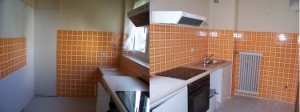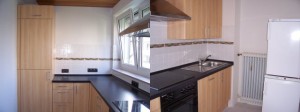I’m catching up on some blogging this week. Yesterday I reported on the paperwork for our new flat. Today, I take a look at how we moved in.
When you think about moving into a new flat, you often have an image of packing up lots of removal boxes and taking everything in a large lorry on a specific day from the old flat to the new one.
In our case, by the time we had the keys and could gain access to the new flat we had long decided that we were going to do as much as possible using our cars and then only have the “big move” for the furniture. Some furniture we wanted to move in advance, to make the “big” day run more smoothly.
But first, we had to deal with our kitchen.

Before...
Although the rest of the flat had been redecorated, the kitchen had not, although it contained an almost new cooker and sink. We needed a new kitchen, and so for the first time since being in Germany I went to a kitchen showroom.
Here modern technology played a big part. Using the measurements that we had already made, we were able to plan our kitchen with 3D graphics, helped by an expert kitchen planner who certainly knew his stuff. In fact, we quickly agreed on how to use the space available, it took a bit longer to decide on the colour for the cupboards and the worksurface.
Over the course of the next few weeks we – helped by our respective families – transported as much as we could between the flats, whilst trying not to hinder our daily working lives. We took furniture apart and rebuilt it. We put tables together for the office.
But perhaps the biggest job of all at this point was to re-tile the kitchen. What should have been a simple job for my wife and father-in-law turned into a much bigger event when it was discovered that the wiring in the kitchen was not up to modern standards, indeed even potentially dangerous in some parts. In the end, over the course of two weeks they re-wired, re-papered and re-tiled the kitchen.
After that we continued to use our spare time to move as much as possible into the flat, until, at the end of August, we shut down the business for a week and, with the help of both families and a friend, we moved our larger furniture and kitchen appliances into the new flat and slept there for the first time.
Not all of this went quite according to plan, though. Our kitchen, that should have arrived in the third week of August was now not scheduled until after we moved in, so we made do with a coffee machine, a microwave oven and a fridge. Water had to come from the bathroom. But then, finally, on the last Friday in August, our kitchen arrived.
For around six hours two kitchen builders built, mounted, wired and plumbed in our kitchen. At the end of it all we had a lovely fitted kitchen where everything worked. We even had modern drawers that you don’t shut right up – you give them a push and they go in normally until, just before they shut completely, they brake and “zish” in slowly.

... and after
It was time to relax, but only for the weekend. The following Monday the business re-opened and we had to catch up on all the phone calls and e-mails. We had been worried that our phone line might not have been re-connected in time, but everything worked fine.
However there was still work to be done. Most of our cutlery and crockery were still in the old flat. Any spare time we had in the following week was taken up with moving things out of the old flat and into the new one.
Now, thankfully, that process is almost finished. But that doesn’t mean that we can stop paying the rent just yet…


